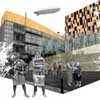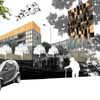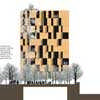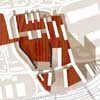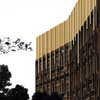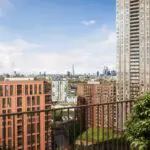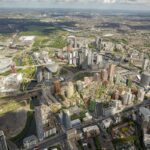Robin Hood Gardens Competition, 20th Century Homes London, Residential Building, Architect, Images
Robin Hood Gardens Competition
Modern Housing in Poplar, East London, England – original building design by The Smithsons
page updated 3 Aug 2016 ; 23 Jun 2008
Robin Hood Gardens Contest
Kraft Shortlist Success
Robin Hood Gardens Competition Design
Kraft Architecture working with Mike Hyatt Landscape Architects has been shortlisted for the ‘Save Robin Hood Gardens’ Competition sponsored by BD Magazine.
The competition is part of an ongoing campaign by Building Design Magazine to save the landmark Robin Hood Gardens Estate designed Alison + Peter Smithson.
Our regeneration masterplan involved introducing a greater variety of commercial & arts based mixed use development to provide better employment opportunity and encourage diversification.
The proposals exploit existing and potential new levels across the site to create a continuous landscape that visually connects the whole area to the wider urban fabric.
This ‘blanket’ surface sympathetically incorporates the striking original landscape features of the Smithson’s original proposals.
The introduction or a wider range of social activity and community support facilities illustrate how this run down area of London could become a dynamic place without losing it’s distinctive character and historic urban grain.
Details of how the existing homes might be sympathetically upgraded were explored through the use of sensitive and sustainable extension and renovation proposals.
A reduced version of KRAFT ARCHITECTURE’s presentation is below
Robin Hood Gardens Competition Design by Kraft Architecture
Save Robin Hood Gardens Competition – Design Statement
Urban Fabric
The notional symbolism of the existing buildings as ‘cliff face’, the use of the moat car parking feature combined with the very wide and busy roads around Robin Hood Gardens cut the residents off from the shops & facilities of the surrounding area, severely limiting physical & psychological connections.
We believe that for a place to be ‘somewhere’ rather than ‘anywhere’ it must be woven into the urban grain.
We aim to strongly reconnect the island making broad pedestrian crossings over adjacent roads, giving generous pavement width down Cotton St and East India Dock Rd forming a boulevard edge encouraging free flow of pedestrians. Reforming the link from Poplar High St to Naval Row and creating new internal connections make sure that all parts of the site are easily accessible.
Public Realm
We consider the use and quality of the pubic realm to be a key driver in urban regeneration. To this end, our proposals include enhancing a stretch of Poplar High St to Naval Row & the linking roadway of Cotton Street with new ground scape materials, landscaping, artworks and signage.
Well Being
Enhanced accessibility from without and within the site is balanced by the ability to secure parts of the site as required. Large glazed security screens provide creative canvass for digital art within the landscape but still allow views through, giving essential control & overlooking for residents’ that allows them to have their ‘defensible spaces’ crucial for engendering the residents’ sense of well being.
Breathing Spaces
We propose to extend Robin Hood Gardens into a flowing landscape surface that rises and undulates to provide a linking carpet throughout the regeneration area. This surface includes a variety of landscape types including woodland, meadow, lawn, water, seating and sitting areas.
Our elevated landscape flows under the buildings to enhance the feeling of connectivity, reconnecting with the main streets through sloping terraces which form pubic spaces and key access points into the Robin Hood Gardens themselves.
Sustainable Mixed Use
We propose to mix a variety of the existing community facilities, education buildings and commercial opportunities within he gardens and within the proposed blocks. These create opportunities for elderly clubs within the blocks, residents meeting rooms, reading rooms, ground floor cafes and clinics.
Density
Our proposal seeks to evenly spread high density / low rise housing throughout the site, ensuring an even cross site movement of people and activities. The proposals limit the housing blocks to eleven storey’s in height with some lower blocks and a mix of low rise commercial and community facilities through the site.
Housing Blocks are generally arranged facing east/west to minimise overshadowing of the adjacent gardens and to create a varied tenure and housing mix with god connections to the gardens and external spaces. The blocks all feature ‘breathing spaces’ within the structure including balcony spaces, roof gardens and community rooms to help engender innovative an flexible live / work opportunities and resident interaction.
Gathering Spaces
The end of Poplar High Street is proposed as a key urban breathing point, a space for market events, meeting people and accessing community health + leisure facilities. This space is directly linked to the Blackwell Dockland Light Rail Station by a terraced public space which also provides access to key community facilities, health facilities, hotel and a variety of commercial uses including retail, office and leisure. This gathering space is critical to help reconnect Robin Hood Gardens with the wider Poplar area.
Commercial Edges
Whilst aiming to strengthen the end of Poplar High Street by creating a variety of commercial opportunities such as office space, retail and leisure uses, we also propose using the edge along Cotton Street to help link the shopping area at Chirsp Street with the new gathering space. Widening the pavement here, removing the acoustic barrier wall and replacing it with good quality retail, leisure and cafe units will help to soften the boundary of robin hood gardens whilst creating employment opportunities for residents.
Woodland / CHP Heating / Skills
As a means of softening and strengthening the use of Robin Hood Gardens, we propose planting a series of small birch woodland areas within the gardens. These will help provide acoustic separation whilst providing an attractive screening to adjacent areas.
In time the woodland could be harvested on a n ongoing basis for use in a central CHP Unit for the mixed use site. It is envisioned that the timber could also be used as the source material for a small training and skills workshop creating furniture, repairs and artworks for the gardens.
Windows: The Eyes of the Skin
As part of wider renovation and maderisation works, we would propose to replace existing fenestration with FSC Accredited Timber Windows, Triple Glazing and Thermally Broken Frames. These will have integral moisture controlled passive vents which will greatly enhance the performance of the existing houses thermally and help to contribute towards a healthier interna living environment.
The modulation of opaque / transparent elements of the new fenestration will be co-ordinated with the Smithson’s own facade modulation treatments.
Extending + Adapting
An engineered timber skin is proposed for the garden facades of existing Robin Hood Garden blocks. The structure will envelop the existing structures providing more useable terrace spaces and allowing expansion of he existing units to me new housing standards.
This grafted structure also forms a two storey ‘extension’ to both blocks and would be used to create the new community facility spaces located within the blocks adjacent the vertical circulation stacks.
The use of robust and suitably treated timber enables the creation of a sympathetic, sustainable and easily repairable structure that adapts, reinterprets and extends the life of the original Robin Hood Garden towers.
Nature fills a Void
It is envisioned that the use of such a structure would also enable the green blanket of the proposed extended Robin Hood Gardens to reach up onto the buildings, creating green facades that encircle the primary green space of the Smithson’s original grass mound. This green enclosure would shift the Smithson’s vision of using the mound to view the blocks from a different horizon onto a a similar reinterpretation of the resident’s environment as they had envisioned.
Reclaiming the unloved Spaces
Both the existing blocks and the new blocks would have a variety of community spaces clustered around the vertical circulation cores to create activity and encourage ‘ownership’ of these spaces. Residents will be encouraged to claim back areas of communal space, re-sue and adapt it.
Streets in the Sky
We propose to re-establish the ‘streets in the sky’ notion of corbusier and the smithsons. We are proposing to create higher quality spaces which connect with residential units by establishing planted areas along each walkway, a new materiality, seating, storage areas, and a range of community facilities which open out onto these skywalks. This will help to reclaim these unloved spaces for the residents.
Luminosity
In order to ensure that the area remains in the hands of the residents after nightfall, we have proposed using community facilities, walkways and facade lighting to create a safe and inspiring environment which apart from providing safer spaces, seeks to make the gardens an attractive place to use 24/7.
Location: Robin Hood Gardens, London, England, UK
London Buildings
Contemporary London Architecture
London Architecture Designs – chronological list
London Architecture Walking Tours by e-architect
East London Housing
Blackwall Reach, Tower Hamlets
Design: C. F. Møller Architects
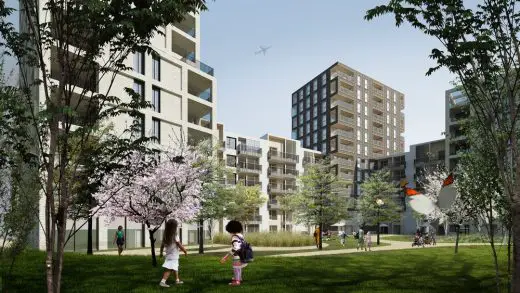
Court Yard View CGI
Blackwall Reach Development
Stratosphere Homes, Stratford
Architects: Allies and Morrison / Stockwool
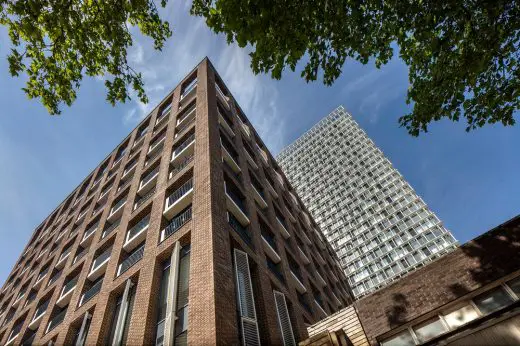
photo : Morley von Sternberg
Stratosphere Homes
Comments / photos for the Robin Hood Gardens Estate London page welcome

